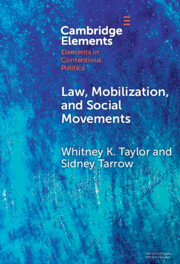246 results

Law, Mobilization, and Social Movements
- How Many Masters?
-
- Published online:
- 06 March 2024
- Print publication:
- 28 March 2024
-
- Element
- Export citation
Response to Samuel L. Popkin’s Review of Movements and Parties: Critical Connections in American Political Development
-
- Journal:
- Perspectives on Politics / Volume 20 / Issue 3 / September 2022
- Published online by Cambridge University Press:
- 31 August 2022, pp. 1057-1058
- Print publication:
- September 2022
-
- Article
- Export citation
Crackup: The Republican Implosion and the Future of American Politics. By Samuel L. Popkin. New York: Oxford University Press, 2021. 347p. $27.95 cloth.
-
- Journal:
- Perspectives on Politics / Volume 20 / Issue 3 / September 2022
- Published online by Cambridge University Press:
- 31 August 2022, pp. 1053-1055
- Print publication:
- September 2022
-
- Article
- Export citation
References
-
- Book:
- Power in Movement
- Published online:
- 25 August 2022
- Print publication:
- 11 August 2022, pp 302-342
-
- Chapter
- Export citation
Dedication
-
- Book:
- Power in Movement
- Published online:
- 25 August 2022
- Print publication:
- 11 August 2022, pp vii-viii
-
- Chapter
- Export citation
9 - Movements in Revolutionary Cycles
- from Part III - Dynamics of Contention
-
- Book:
- Power in Movement
- Published online:
- 25 August 2022
- Print publication:
- 11 August 2022, pp 211-233
-
- Chapter
- Export citation
5 - How Movements Make Meanings
- from Part II - The Powers in Movement
-
- Book:
- Power in Movement
- Published online:
- 25 August 2022
- Print publication:
- 11 August 2022, pp 121-139
-
- Chapter
- Export citation
1 - Where Did Movements Come From?
- from Part I - Origins, Theories, and Contentious Action
-
- Book:
- Power in Movement
- Published online:
- 25 August 2022
- Print publication:
- 11 August 2022, pp 25-48
-
- Chapter
- Export citation
Preface and Acknowledgments
-
- Book:
- Power in Movement
- Published online:
- 25 August 2022
- Print publication:
- 11 August 2022, pp xiii-xvi
-
- Chapter
- Export citation
2 - Capitalism, States, and Social Movements
- from Part I - Origins, Theories, and Contentious Action
-
- Book:
- Power in Movement
- Published online:
- 25 August 2022
- Print publication:
- 11 August 2022, pp 49-72
-
- Chapter
- Export citation
Figures
-
- Book:
- Power in Movement
- Published online:
- 25 August 2022
- Print publication:
- 11 August 2022, pp x-x
-
- Chapter
- Export citation
11 - Transnational Contention
- from Part III - Dynamics of Contention
-
- Book:
- Power in Movement
- Published online:
- 25 August 2022
- Print publication:
- 11 August 2022, pp 259-281
-
- Chapter
- Export citation
Copyright page
-
- Book:
- Power in Movement
- Published online:
- 25 August 2022
- Print publication:
- 11 August 2022, pp vi-vi
-
- Chapter
- Export citation
6 - Regimes, Opportunities, and Threats
- from Part II - The Powers in Movement
-
- Book:
- Power in Movement
- Published online:
- 25 August 2022
- Print publication:
- 11 August 2022, pp 140-167
-
- Chapter
- Export citation
7 - Struggling to Reform
- from Part II - The Powers in Movement
-
- Book:
- Power in Movement
- Published online:
- 25 August 2022
- Print publication:
- 11 August 2022, pp 168-190
-
- Chapter
- Export citation
Conclusions
- from Part III - Dynamics of Contention
-
- Book:
- Power in Movement
- Published online:
- 25 August 2022
- Print publication:
- 11 August 2022, pp 282-301
-
- Chapter
- Export citation

Power in Movement
- Social Movements and Contentious Politics
-
- Published online:
- 25 August 2022
- Print publication:
- 11 August 2022
-
- Textbook
- Export citation
Index
-
- Book:
- Power in Movement
- Published online:
- 25 August 2022
- Print publication:
- 11 August 2022, pp 343-359
-
- Chapter
- Export citation
Maps
-
- Book:
- Power in Movement
- Published online:
- 25 August 2022
- Print publication:
- 11 August 2022, pp xi-xi
-
- Chapter
- Export citation
8 - Cycles of Contention
- from Part III - Dynamics of Contention
-
- Book:
- Power in Movement
- Published online:
- 25 August 2022
- Print publication:
- 11 August 2022, pp 193-210
-
- Chapter
- Export citation



